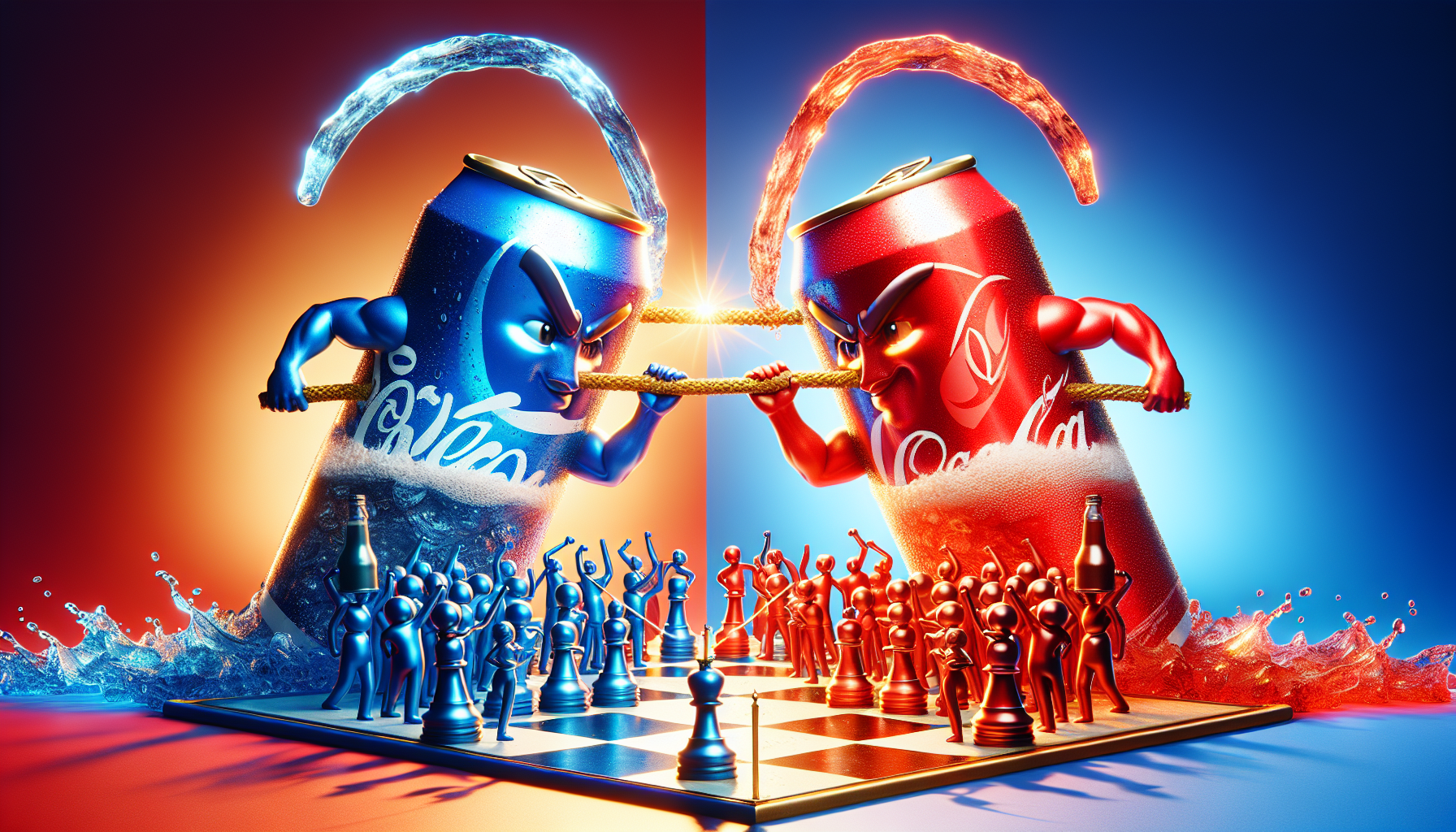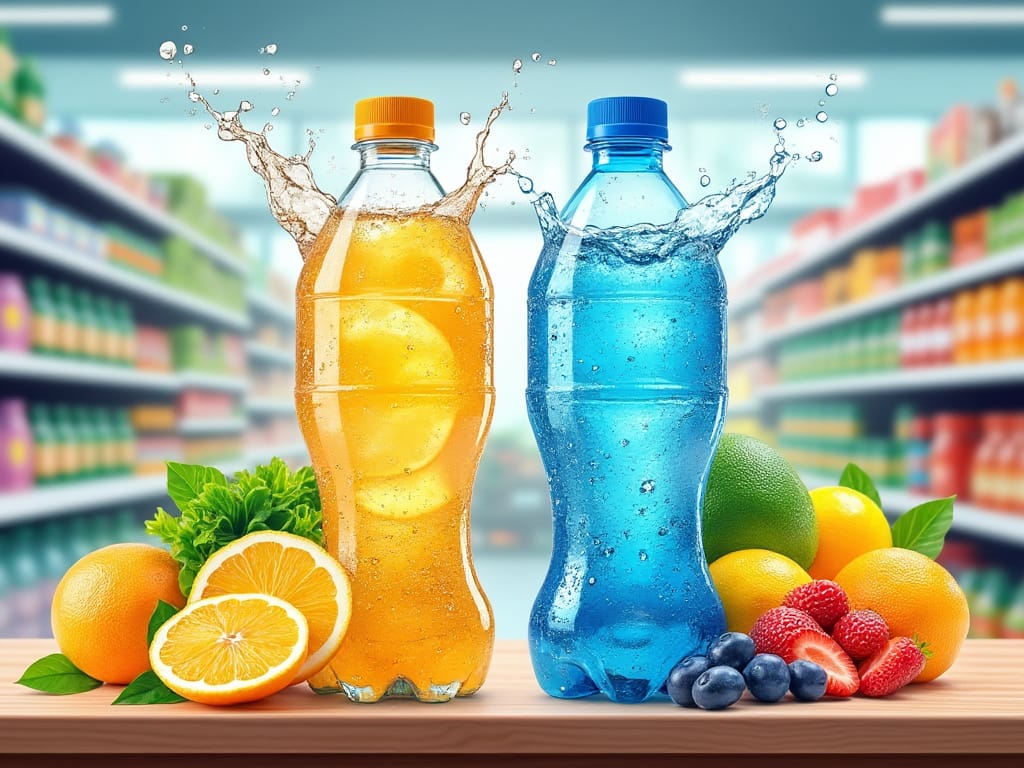CleverCompete - Coca-Cola Vs PepsiCo - Which beverage has Market Rizz?
Codemonk's CleverCompete validates the market dominance of carbonated beverages with competitor analysis

When conducting the product feasibility of our CleverCompete competitor Analysis, Business Analysts at Codemonk essentially had to consider global conglomerates that competed for the same market share. We looked at companies with similar SKUs in their product portfolio and tried to understand how both performed in the market, when subjected to similar kinds of critique, demand, and skepticism, among other subjective factors. Our search brought us to the carbonated beverages space, with globally recognisible fizz drinks, CocaCola and Pepsi, for easy and quick comparison, inclusive of the above subjective factors.
Battle for the beverages market share between Coca-Cola and Pepsi is not just about which drink tastes better or is the healthier choice among the two, but rather about how each company has appeased the consumers around the world. These two giants have been locked in fierce competition, constantly striving to gain an edge in consumer preferences and sales volume. Their rivalry has led to innovative marketing strategies, product differentiation, and global expansion efforts that have influenced the entire soft drink market.
Both companies have invested heavily in advertising and brand identity to maintain their competitive advantage. Their struggle for dominance extends beyond just cola products, encompassing a wide range of beverages and snacks. As they continue to vie for consumer loyalty in international markets, factors such as distribution channels, customer relationship management, and market positioning play crucial roles in determining their success. The ongoing Coca-Cola and Pepsi market share battle provides valuable insights into brand competition and business tactics in the modern global marketplace. When we tasked our competitor analysis solution--CleverCompete--to studying both companies, we could not simply make an objective analysis of both businesses, because financial statement analysis and rudimentary market study only goes so far in providing a clear picture of who comes on top of the other. Hence, we looked at
1) Consumer Preferences
2)Brand Loyalty
3) Health Consciousness
4) Competitive Marketing Strategies
5) Future Outlook
These factors allowed us to make a definitive case as to why consumers might prefer one over the other. Lets look at each of those factors, and you can tell us if you agree with our analysis or not.
Consumer Preferences
The battle for market share between Coca-Cola and Pepsi is largely influenced by consumer preferences. These preferences are shaped by various factors, including taste, brand loyalty, and health consciousness.
Taste Tests
Taste has always been a crucial factor in the cola wars. In 1975, Pepsi launched the "Pepsi Challenge," a blind taste test that aimed to disrupt Coca-Cola's dominance. The results were surprising, with , 42% choosing Coca-Cola, and 6% having no preference. This marketing campaign highlighted the importance of taste in consumer decision-making.52% of participants preferring Pepsi

However, taste preferences are not always straightforward. A study evaluating the "Pepsi Paradox" found that while most people stated they preferred Coca-Cola products, blind taste tests revealed a preference for Diet Pepsi over Diet Coke. This suggests that factors beyond taste play a significant role in shaping consumer preferences.
Brand Loyalty
Brand loyalty is a key component in the coca cola and pepsi market share battle. Despite taste test results, many consumers remain loyal to their preferred brand. A study showed that Coca-Cola retained 94.4% of its loyal households from one quarter to the next, while Pepsi kept 91%. This high level of brand loyalty demonstrates the strong emotional connections consumers have with these brands.
Interestingly, when consumers were informed which drink was which during taste tests, more people said they enjoyed Coca-Cola and were more inclined to purchase it over Pepsi. This highlights the power of brand identity and how it can influence consumer perceptions and choices.

Health Consciousness
As health consciousness grows among consumers, both Coca-Cola and Pepsi have had to adapt their strategies to maintain their competitive advantage. Many people are now more aware of the health implications of consuming sugary beverages, which has led to a shift in preferences.
In response, both companies have expanded their product lines to include healthier options. Diet sodas have become a bright spot for both Coca-Cola and PepsiCo in an otherwise challenging market where regular cola sales have declined. Currently, diet sodas make up 27% of the carbonated soft drink market.

However, health concerns continue to impact consumer choices. When people commit to a healthier lifestyle, soft drinks are often one of the first items eliminated from their diet. This trend has pushed both companies to innovate and offer alternatives that appeal to health-conscious consumers.
Despite these challenges, taste remains the most important factor for consumers when choosing carbonated soft drinks. A report by Mintel states, "Considerations like sustainability factors and health benefits will not outweigh taste, yet consumers are considering a longer list of factors before making their CSD choices, putting brands on the spot to check more boxes and meet expanded needs".
In conclusion, consumer preferences in the cola market are complex and multifaceted. While taste plays a crucial role, brand loyalty and health consciousness also significantly influence purchasing decisions. As the market continues to evolve, Coca-Cola and Pepsi must stay attuned to these changing preferences to maintain their market positioning and continue their fierce competition for consumer loyalty.
Competitive Strategies
In the ongoing coca cola and pepsi market share battle, both companies have employed various tactics to gain a competitive advantage. These strategies encompass pricing, product placement, and customer engagement, all aimed at capturing and retaining a strong customer base.
Pricing Tactics
Pepsi has implemented a value-based pricing strategy, setting prices based on the perceived value of their products to customers rather than solely on production costs. This approach allows Pepsi to align its pricing structure with customer demand and expectations. Additionally, Pepsi utilizes , adjusting prices based on location and market conditions to effectively compete in different markets.
To increase sales volume and attract new customers, Pepsi employs discounts and promotions as part of its pricing strategy. This not only helps Pepsi gain market share but also builds customer loyalty. In recent years, Pepsi has introduced a hybrid everyday value model, combining both high and low price points to cater to different customer segments and accommodate varying budgets.
Coca-Cola, on the other hand, adopts a "meet-the-competition" pricing strategy. They set their product prices around the same level as their competitors to be perceived as different but still affordable. This approach has allowed Coca-Cola to maintain its market positioning while remaining competitive.
Product Placement
Both Pepsi and Coca-Cola have intricate distribution channels to ensure their products reach consumers effectively. Pepsi focuses on building strong relationships with distributors and utilizes Direct Store Delivery (DSD), which involves delivering products directly to retailers. This approach ensures that Pepsi products are consistently stocked and displayed in stores, maximizing visibility and accessibility for consumers.
Pepsi has also strategically partnered with international restaurant brands, expanding its distribution reach and allowing its products to be readily available across a wide range of food service establishments. This strategy has enabled Pepsi to tap into existing customer bases and leverage established reputations.
Coca-Cola, similarly, has a robust distribution channel that focuses on reaching consumers through various channels. Their approach includes partnerships with a wide range of retailers, from grocery stores to internet merchandisers. This allows Coca-Cola products to be available in multiple locations, catering to the diverse shopping preferences of consumers.
Both companies have also invested heavily in product pairing strategies. By consistently incorporating product pairing in their ads, they have created memorable connections between their beverages and specific food items or occasions. This tactic has helped establish their products as essential add-ons to popular meals and has strengthened their brand associations.
Customer Engagement
In the realm of customer engagement, both Pepsi and Coca-Cola have recognized the power of social media in reaching their target audience and promoting their brands. They have developed comprehensive social media strategies to engage with customers and create a strong online presence.

Pepsi's social media campaigns often feature popular celebrities and influencers, leveraging their large followings to increase brand visibility and reach. For example, they have partnered with stars like Britney Spears and Kendall Jenner to create buzz-worthy content that appeals to their youthful audience.
Coca-Cola, on the other hand, focuses on creating emotional connections and promoting positive experiences through their social media campaigns. They often highlight heartwarming stories and moments of happiness, aligning with their brand messaging of spreading joy. Coca-Cola's campaigns also encourage user-generated content and engagement, such as their 'Share a Coke' campaign where customers could personalize their Coke cans with the names of their loved ones.
Both companies have also invested heavily in sponsoring music and sports events, recognizing their potential to connect people across the globe and build strong communities. For instance, Coca-Cola has a long-standing partnership with the Olympic Games, establishing its presence in every single host city since 1928.
Through these competitive strategies in pricing, product placement, and customer engagement, both Pepsi and Coca-Cola continue to vie for market share and consumer loyalty in the global beverage industry.
Future Outlook
As the coca cola and pepsi market share battle continues, both companies are adapting to evolving market trends, diversifying their product portfolios, and leveraging technological advancements to maintain their competitive advantage.
Market Trends
The global soft drinks market is projected to expand at a , with the . This growth is driven by rising disposable incomes, changing lifestyles, and a growing population. However, the industry faces challenges as consumers become more health-conscious and seek alternatives to traditional carbonated beverages.CAGR of 5.2% from 2022 to 2028market size valued at USD 416.19 Billion in 2021
The carbonated segment still dominates the market, contributing to the largest revenue share of around 70% in 2021. However, the non-carbonated segment is expected to register the highest CAGR of 6.9% from 2022 to 2028. This shift reflects the growing demand for healthier options, including low-calorie, low-carb, and functional beverages.
Both Coca-Cola and Pepsi are responding to these trends by expanding their product lines to include healthier alternatives. They are investing in research and development to create beverages that cater to consumers' evolving preferences while maintaining their brand identity and market positioning.
Diversification Plans
To address changing consumer preferences, both companies are diversifying their product portfolios beyond their flagship carbonated drinks. PepsiCo, in particular, has an advantage in this area, as it generates more than half of its revenues (~51%) from its snacks business. This diversification partially shields PepsiCo from the challenges facing the carbonated soft drinks (CSD) category.

Coca-Cola is also expanding its offerings, introducing new products such as Flashlyte, an advanced hydration drink, and smartwater alkaline 9.5+ pH with antioxidant in North America. The company is also exploring the Alcohol Ready-to-Drink (aRTD) category, demonstrating its commitment to diversification.
Both companies are focusing on functional beverages, which are fortified with vitamins, minerals, and other ingredients that offer health benefits. This trend caters to consumers who are looking for products that not only quench thirst but also provide additional nutritional value.
Technological Advancements
Coca-Cola and Pepsi are leveraging artificial intelligence (AI) and other emerging technologies to enhance their marketing strategies and improve consumer engagement. Coca-Cola, for instance, is using AI to create personalized marketing campaigns and interactive experiences that can be tailored to different markets and cultures worldwide.
The company has also introduced innovative products like the Coca-Cola Freestyle fountain platform, which uses AI and real-time cloud connectivity to analyze purchasing decisions and provide valuable consumer insights. This data-driven approach allows Coca-Cola to respond more quickly to market trends and consumer preferences.
PepsiCo is similarly investing in AI technologies to improve its marketing and product development processes. The company uses AI for personalized marketing campaigns, quality control of digital ads, and consumer insights to create innovative products.
Both companies are also focusing on sustainability initiatives, recognizing the growing consumer demand for environmentally friendly practices. Coca-Cola has committed to making 25% of its packaging reusable or refillable by 2030. While PepsiCo is yet to announce a specific target, it has pledged to set a refill and reuse goal by the end of 2022.
As the coca cola and pepsi market share battle continues, both companies will need to balance their traditional strengths with innovation and adaptability. By embracing market trends, diversifying their product portfolios, and leveraging technological advancements, they aim to maintain their competitive advantage in the ever-evolving beverage industry.
Conclusion
Although CleverCompete created a majority of this report with the consumer in mind, this battle for market dominance showcases the importance of brand identity, customer loyalty, and the ability to respond to evolving consumer demands in the competitive business landscape.
As these beverage giants continue to vie for market share, their strategies offer valuable insights into brand competition and business tactics in the modern global marketplace. CleverCompete is designed to keep tabs on all such advancements, particularly for brands under its study. You could also create such detailed reports yourself for any two entities with similar data published on the public domain; the format of which was recently published in this blog You could also choose to create a much more granular, business focused, competition analysis with private APIs providing insights into consumer behavior patterns as well. To gain more insights into how businesses navigate competitive landscapes and adapt to market changes, do chech out CleverCompete for yourself, And as always, stay tuned for more such techological explorations.

